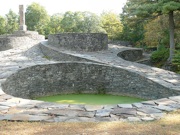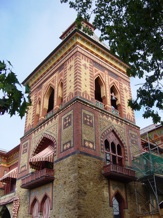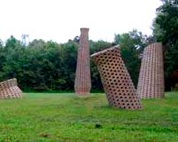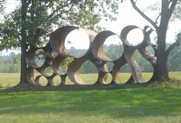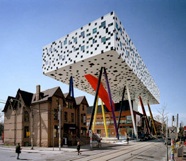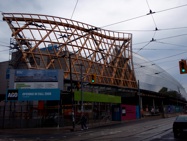arslocii
placeness as art


arslocii
placeness as art




































Quest for artistic endeavor along
the Hudson River
Our journey to the Hudson region this time was spent in the Middle and Upper Valley and on both sides of the river, with a border-crossing into Ontario. Cities are different challenges for art-and-site matches because there usually is not enough nature to balance out the ubiquitous manmade environment. The Hudson River corridor has a perfect combination of natural wildness combined with the wherewithal of a population having money, education and a desire to create the symbiosis we are seeking.
Springside
Poughkeepsie, NY
Many of America’s aristocratic rich, mostly during the last part of the 19th century, found land and built country homes with picturesque landscapes along the Hudson. Springside, wealthy brewer and college founder Matthew Vassar’s ornamental farm, was designed by Andrew Jackson Downing and Calvert Vaux on a 50-plus acre site at the city’s border. It has now almost disappeared, only a hundred years after it was completed. All that is left, and it’s not much, is what was once the estate’s fashionable pleasure garden. After zoning battles and fires, what remains of Springside looks at first like a weed-filled thicket among sprawling condominium development. It is not easy to find, and other than the sole remaining original structure – the gatehouse across from the thicket – there are no signs or signals. Entering the thicket is akin to walking into a stand of trees along a highway with no one else around on foot or in a car – you start to question whether you should continue on. Ah, but you should. Once you enter, your world changes. First, you go from bright sunlight into a shady woodland. Paths start to appear, and as you follow them around outcroppings and hillocks, your orientation alters and meaning unfurls. Continuing on, you walk through what seems like wilderness and randomness, but vistas open up. It helps that there are placards offering reproductions of original lithographs and sketches revealing what you might have seen of the estate at this spot or that one – a view here, an apiary there, a fountain, a pagoda, the Gardener’s Cottage – all in the Gothic Revival style. There is something so powerful in the absence of these focal points of the garden and the remarkableness of its bones, the structure of the landscape still very present. There is such a ghostly feel to the land, like a haunted house, a sense that someone built this and inhabited it and the spirits continue to reside there. It feels almost like a sacred site, the combination of presence and absence. The picturesque qualities of the garden have long since passed away, but the feeling, the logic, the plan, the balance of natural and designed is all very much still there.
Montgomery Place
Annandale-on-Hudson, NY
A rather more intact example of A.J. Downing’s handiwork (this, in association with architect Alexander Jackson Davis) are the 400-plus acre grounds of this impressive estate, built in memory of a fallen hero of the Revolutionary War by his widow. The house was under renovation when we arrived but it didn’t matter since the landscape and gardens were what we came for, anyway. It is worth getting the audio tour and listening while walking the meandering paths, since the place has so much history surrounding it. There is much to see and experience, especially the authenticity of the park-like atmosphere of the grounds with later-added layers of the picturesque style – a style that creates the idea of a landscape as a kind of picture gallery to stroll leisurely through ... only you get to inhabit the paintings rather than just imagining doing so. Here is this amazing thing, a site of great natural beauty high on a scenic bank of the Hudson, and yet it is but one component of the whole experience because the rest of the surrounding landscape was designed in a kind of complementary naturalistic style. There is an arslocii about this combination of natural and manmade because the manmade portion fits so well with the original. Some of the garden “rooms” were added in the 20th century, including an elliptical aquatic pool that looks bottomless and has a mystical, serene quality (one wonders if such calming was as necessary then as it is now). This Place has its history but it is a very much in-the-present garden that lulls you into thinking that there is no other place on earth you would rather be.
Opus 40
Saugerties, NY
Another quarry. Pity the poor Catskills and Hudson Valley, mined for the very things that make them beautiful: stone and trees. This one, though, has been made remarkable in a totally different way from Manitoga. A vision that only an obsessive personality could muster, Opus 40 is a life’s work. Harvey Fite, a sculptor, started out building pedestals from the remainders of bluestone in the abandoned quarry in order to elevate and enhance his pieces. The sculptures are there, but his focus obviously shifted to one of complete immersion in restructuring and reconfiguring the site. Built entirely from the quarry’s stone, this 6-acre sculptural wonder of the world is unique and yet reflects a knowledge of monumental art and architecture history. As you walk through its terraces, ramps, stairways, bridges, caves, promontories, sunken gardens, serpentine walls (the complexity is surprising), you feel as if you are taking a global tour of ancient ruins. And yet there is something so WPA about the look of it. If you can get beyond the “gee, this was a lot of work” attitude, there is something ritualistic and spiritual about the site, a Machu Picchu-ness given its location and the structures that appear to have some organized purpose. However, it was all accomplished by one man, alone. Check out his studio and the collection of quarry tools and artifacts. And walk out into the less-built areas and see all the rock-balancing “thank yous” that other visitors have left in response to Fite’s work. The incredible force of will that is expressed here, the hard-surface structures that cover the site in such inventive and connective ways, and the fact that all the material was here – it’s just rearranged – makes for an arslocii moment. There is here a powerful pairing of man and mountain.
Olana
Hudson, NY
How is it that Frederic Church, the artist who painted the Hudson landscape, was able to obtain the perfect site for viewing, painting and living on the river’s cliff edge? Although any view of the Hudson is lovely, Olana must have the loveliest – right at a bend, on a perch, almost 360° vistas, directly across from the best part of the Catskills to the west – looking as if they are meeting you on an equal aerial footing but then extending out to the horizon in a perspectival recession of greens, blues and purples. The view from Olana is scarily exquisite, overwhelmingly so. You might think that no house could compete with such a setting, and mostly you would be right. Except for Olana. The Victorian Moorish style pokes out of the site like some kind of medieval Middle Eastern castle with geometric ornamental brickwork. The architecture was designed by Calvert Vaux, and the exterior detail is textural, carrying out the subtle desert-like colors of its co-opted design inspiration, every surface addressed with a decorative motif. Church’s design of the land surrounding the house – originally a working farm – addressed aesthetics in every conceivable way, composing his landscape always with an eye to the view. The interior of the house, too, continues the Persian scheme with more surface decoration: stencils, carving, weavings – anything and everything that can be illuminated by the theatrical natural light. There are amazing views out to the landscape framed by the pointed arched windows. Besides the view, check out the interior paint colors (greens, blues, purples, yellows again) with a depth of glazes and/or surface reflectivity that only a true master could conjure, complementing the dramatic landscape and giving it a run for its money. A little bit of paradise on earth.
The Fields Sculpture Park
Ghent, NY
This is another of those hard-to-find places, since it is on farm land and there are no signs. Part of the Omi International Arts Center, on Letter S Road (S stands for sculpture?), there is a gravel pull-off with a more contemporary but unfinished building that seems to be a likely candidate for something non-farm. As you walk up the grassy hill there is a sculpture to greet you and you realize fairly soon that the contours of the land prevent the views that would explain what is there – it is a lovely rolling site, mostly cleared, with surrounding clumps of trees. One might expect to see sheep in a setting like this. And, oh yes, there they are – sheep, as expected, in a pen area. There are no other visitors anywhere in sight, and it is weirdly quiet in this grazing pasture for art. The sculpture alone seems to own the place (except for the sheep, and they are, it seems, one of the installations by artist Dan Devine). Many large-scale works ruminate out in the open grassy fields (hence the name) and some are well-situated, but probably the most interesting ones are those that are hidden in the wooded areas. One with a powerful pairing of art to site is Charles Ginnever’s “Apollo” and its setting in a clump of trees. If you don’t look up, you might miss it hovering overhead, a very long yellow steel shaft that ricochets through the trees like a lightning bolt strike. This same area houses other more site-specific pieces – a group of them in the thicket adjacent to a swamp, others placed at the woodland edge between open/sunny and tree-filled/shaded.
The works in and around the trees are more discoverable than are the ones holding their own in mid-field. That being said, there are some that really take advantage of the open space, and also in the titling vis-a-vis the site: like Foon Sham’s “Vessels on the Field,” looking like a bit of archaeology, and John Ruppert’s “Valley Orbs,” which harken to post-industrial hay mounds or tumbleweeds. This sculpture park is not exactly a place that has been landscaped but rather a place that has many facets of land to work with or against, and which offers an infinite variety for art-and-site combos. One hillside has what looks like student works, making the permanent art look even more impressive – clever ploy. There are no paths or directional cues, but that is not bad considering how enjoyable walking up and down hill and dale is. Sometimes you feel like you could lie down and body-roll to the next piece, letting the art stop you on the downslope. One wooded patch to the rear of the property might have had more in it to see but as we approached, gun shots were fired and we decided not to enter. Based on one of the pieces near the swamp – sheet metal filled with hundreds of bullet holes – it could have been an artist at work, or it could have been hunters on a neighboring property. No way to know, so, as silent and meditative as the place had been, the startling gunfire was the signal to move on. There is a special “placeness” about The Fields, maybe because of its isolation, maybe because it offers plenty of opportunity for arslocii. At this first viewing, though, the sheep get our vote.
Toronto Music Garden
Toronto, ON
At a very-much-in-need-of-green location – a result of one of those terrible ideas of putting interstate highways (or whatever they are called in Canada) along waterfronts, thereby cutting off the city from its natural connection and creating a nearly impenetrable concrete barrier to the water, forming a dead zone with no pedestrians and no possible reason to want to be one – there is now an amazing waterfront garden/performance space. And as clever a design as you’ll see or hear. It is based on Bach’s Suite No.1 for Unaccompanied Cello –and is, appropriately, the brainchild of famed cellist Yo-Yo Ma and a team of landscape architects and artists, led by Julie Moir Messervy – with each garden room expressing one of six dance movements, designed with the feel of the music reimagined in its form and its plantings. Viewed from above, the park becomes a curvaceous parterre that would be the envy of Louis Quatorze. It also resembles a filagree or scarab design, but, either way, it is certainly a jewel set in the merger of water and land for the city. Serious, playful, smart and useful, this wonderful amendment to the disrupted harbor front translates the idea of classical music into the stuff of designed and contained nature. And, in one fell swoop, offers a much-needed oasis in an otherwise barren zone. When you are in the garden you are somewhere else, transported as if by music.
Royal Ontario Museum
Toronto, ON
As we have noted, city sites often don’t have the powerful arslocii balance we seek. But there are exceptions. This museum addition has something akin to that relationship in the merging of two manmade structures. Frank Darling and John A. Pearson’s 1914 Neo-Romanesque original building looks as if it is being devoured by the 2004-08 Deconstructivist addition, the Michael Lee-Chin Crystal, a creation of architect Daniel Liebeskind. Talk about contrasts, not only of design sensibilities but also materials – they could not be more diametrically opposed. However, somehow, the balance is there, not just between the classical permanence and the free-form apocalyptic references, or even the massiveness and solidity of stone versus the lightweight but penetrating shards of aluminum/glass, but between the two individualistic and monolithic buildings now linked in a 21st-century dance. The new embraces and yet chews away at the old, making them conjoined twins from different generations and different aesthetics, maybe even different planets. And the result, surprisingly, is that neither one would be as compelling without the other. Also, if there hadn’t been the overlap, the intrusion of one facade onto the other, it might not have worked – it would have looked like two very unhappy next door neighbors, one of them in the wrong neighborhood. Some might consider the new part an abomination, a betrayal, even, like some virus eating the flesh of Canadian civility. However, of the old building and the new addition, one steadies, the other is emphatic. It is a kind of parent/child engagement – totally immersed in each other, battling for control, in a clench of both love and struggle.
Sharp Centre for Design
Toronto, ON
Just a mention of another wonderful structure in Ontario’s fair city – the Sharp Centre for Design, at Ontario College of Art & Design, by architect Will Alsop. It could be confused with a giant Memphis Style table built and hovering above the other more staid school buildings, looking a bit spindly-legged like a newborn fawn. Perfect as an art school building, it is art itself. The twelve primary-colored legs resemble a pack of Crayolas unwrapped, and the black and white design (“pixilated”) of the building’s exterior cleverly disguises not only the windows but also the massiveness of the building, as does the floating illusion. It also serves as a gateway into and a roof over a park where all the students get a little fresh air, a transition from busy street to green open space. Though it messes with your mind and looks like an alien vessel that has landed in amongst the surrounding cityscape, ready to suction up the samples below it for analysis, it sits playfully, invitingly, happily on its site, and you can’t imagine the streetscape without it. As clever a use of air space on an over-crowded site as you’ll likely see, it doesn’t intrude and it makes you smile, and as a piece of architecture it does so much more than is required of it. It is sui generis and yet, in arslocii vernacular, both it and its environment are enhanced by each other, the whole greater than the sum.
Art Gallery of Ontario
Toronto, ON
Just a note about the construction of another Frank Gehry marvel. We have seen some of his finished buildings: the Fisher Center at Bard College and the Jay Pritzker Pavilion at Millennium Park. What is visible at our early-stage viewing of AGO is the armature that eventually will be clad. Witnessing the in-progress stage of transformation is kind of like going behind the curtain in the Land of Oz, because you see the process and the bones. Our thought when encircling the other two completed theaters was how uncannily similar they were to the structural elements we remember from walking around the screens at drive-in movies. Now, having seen the AGO’s unfinished facade, we are even more convinced that Gehry has been influenced by drive-in movie architecture, but interpreted as sculptural and three dimensional rather than straight, flat and blank. The same sleight-of-hand is present in both, and probably so is the use of some of the same materials, like welded steel structure with a thin membrane covering. At AGO, the sculptural qualities of the facade’s presentation on the street looks even better in a city context than it does in a more bucolic setting, since it enlivens and animates an otherwise static street face.
While we were there pondering the changes to AGO, new trolley tracks were being installed in the street in front of the building and around the intersection’s corner, lines and curves converging in a Kandinsky-esque drawing. That was one of the most fascinating things to see, and maybe most meaningful. Maybe, even, most arslocii. We’re not being snide here, but to watch that kind of infrastructure being built, the nearly lost art that trolley-track laying is in the 21st century, made this moment a marvel to behold. There is the perfect union of the tracks embedded in the street, like a compass pointing the way, shiny steel lines interrupting the otherwise bland grey cement, making designs or marks that conjure up both the past and the future. Arslocii can be found in the most unexpected places.

arslocii, a creation of Probasco Haus Press
copyright © 2010 Probasco Haus Press LLC



Left: “Apollo,” by Charles Ginnever, Fields Sculpture Park.
Bottom: Rice Lake at Plank Road, Gores Landing.
Top: Opus 40, Saugerties, NY (image, www.opus40.org/).






